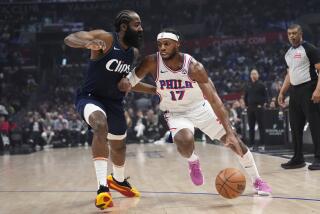The ‘Big Three,’ take two
There is something different with the Miami Heat this season.
It is something that Dwyane Wade can sense when his team goes on the road, playing in hostile arenas.
“You get a few more cheers,” the perennial All-Star guard said. “The fans want to see good basketball.”
Good meaning an 8-2 start as Miami arrives at Staples Center to face the Clippers on Wednesday night. Good meaning that LeBron James leads the league with a 30-point average per game.
“There’s just a comfort, there’s a chemistry,” James said. “Guys know each other and have learned each other.”
The process has been neither easy nor entirely pleasant. At this time last season, the Heat heard mostly boos and criticism as it traveled around the country.
A lot of fans did not like the manner in which James left Cleveland to join Wade and Chris Bosh in South Beach, creating an instant championship contender. Critics took particular satisfaction as the “Big Three” stumbled to a 9-8 start.
Coach Erik Spoelstra clearly recalls all that “outside noise and scrutiny.”
“When you go through a lot of adversity, it makes you stronger and closer, and that happened to us last year,” he said. “Now we’re able to focus on our game and improve.”
Their struggles might serve as a cautionary tale for the Clippers, hoping for big things with Chris Paul: The addition of great talent does not ensure instant success.
Expectations were sky-high for Miami in 2010-11, fueled in part by James’ alluding to a new dynasty when he spoke of winning “not two, not three, not four, not five…” championships.
Even though the Heat reached the NBA Finals and came within two games of the trophy before falling to Dallas, the season was considered a disappointment.
This winter, the NBA lockout grabbed all the headlines, allowing Miami to come in under the radar. And the team, though struggling with injuries, appears to have improved in key areas.
Not only do the players know each other’s styles and tendencies, they also claim to have a better understanding of what their coach wants. As Bosh said: “I had a lot of time in the summer to watch film and see how I can be effective with this team.”
Spoelstra is happier with the team’s defensive approach, which he describes as “disruptive … not gambling.”
At the start of the week, the Heat was averaging 10.1 steals a game while holding opponents under 42% shooting, both ranking near the top of the league. That effort has translated into easy opportunities for an offense that was leading the NBA with a 50% field-goal percentage and 108 points a game.
“Sometimes last year, when we got stops, we kind of walked it up the floor, we didn’t take advantage of our speed and athleticism,” Bosh said. “Now, if we force turnovers or if we force misses, we’re trying to get it up the court as quick as possible.”
When there is no chance to run, James has become more efficient by shooting from the perimeter less often, setting up in the post. As of Monday, he was making 60% of his shots.
The “Big Three” are also getting help.
The Heat was previously viewed as a few superstars in search of a supporting cast. But this season, with James missing time and Wade nursing a stubbornly sore foot, others have stepped up.
That includes Mario Chalmers and Udonis Haslem, who ranks among the NBA’s top rebounders. Rookie Norris Cole, D-League survivor Terrel Harris and free-agent addition Shane Battier have contributed too.
The Heat showed some depth last week by winning at Atlanta in triple overtime with James and Wade in street clothes. While Bosh led all scorers with 33 points, Chalmers added 29 and Harris had 14 rebounds.
“I don’t think anyone gave us much of a chance that night,” Battier said. “That game was huge for [Bosh] and the bench guys, which can only help the team.”
Ten games are not enough to predict how Miami will look in the playoffs, especially after an upset loss at Golden State on Tuesday. And there are still weak points to address — the Heat has struggled against zone defenses and lacks big bodies inside.
But a fast start suggests this team may be on the way to erasing last season’s question marks.
“They get after it night after night,” Golden State Coach Mark Jackson said. “Pushing the ball, making plays, they have home-run hitters in the lineup.”
Adversity has apparently served another purpose. Rash predictions have been replaced by calmer talk about building chemistry.
“Last year was a blueprint for us,” James said. “Good things come to the ones who wait and are patient.”
david.wharton@latimes.com twitter.com/LATimesWharton
More to Read
Go beyond the scoreboard
Get the latest on L.A.'s teams in the daily Sports Report newsletter.
You may occasionally receive promotional content from the Los Angeles Times.











